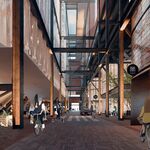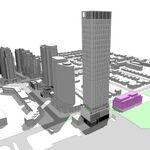People are framing this as an us versus them issue when it should be something that anyone can support.
Waterloowarrior, I agree the us/them arguing wastes time. I don't think anybody would argue against the benefits of biking. From my perspective the debate here is about a) bike lane infrastructure as a funding priority in the current context (inadequate funding for modes of transport that have greater demand and that will have a greater impact on relieving gridlock, the declining economy/recession and a strapped City Hall that is having to make tough funding choices on what some would argue are more essential services) and b) where bike lanes belong if we are going to have them (creating further gridlock along main arteries by removing lanes to accommodate bikes vs the development of a side-street bike route where possible, and balancing the real desire for an urban environment that revolves less around the car and more around pedestrians, bicyclists and mass-transit users with the reality that cycling is only so pragmatic an option for a vast majority of the population for all the reasons discussed - health, mobility, age, time, weather etc).
We need to create complete streets where everyone feels safe. No one here wants to ban cars. Millions of people still own and use cars in places that are more bike-friendly like the Netherlands, and there are still highways and multi-lane arterials.
I think we also have to be careful about emulating a European context too closely. The climate, infrastructure and lifestyle in Toronto are so vastly different than what is typical in Europe. Even there, in the major urban centres 'most' people are relying on public transit to get around.
Where did you get that the total budget for infrastructure spending including transit is only 23M? I am looking at capital budget for 2008 and for Transportation Services alone (which excludes TTC, plus other significant sectors like water and waste) it is 300M; TTC by itself is 925M on top.
AoD, I found it reading the following article (I've just pasted the pertinent point):
City budget offers new spending, property tax hike
ctvtoronto.ca
$23.5M investment
The budget also highlights $23.5 million in investments the city is planning to make in areas of climate change, transit, public spaces and social services.
Along with government partners, Toronto is investing in:
- transit services across the city
- making the Streets to Homes program permanent
- thirty-five new or enhanced programs for at-risk groups including seniors, youth, women and aboriginal youth in priority neighbourhoods
- the city's new 311, 24-hour customer service contact centre
- nursing shifts in hospital emergency rooms in an effort to reduce wait times
- maintaining snow clearing and removal service
- Toronto Public Libraries by increasing operation hours under the self-service project
- the number of recreation programs at various community centres
- 3,500 pieces of new street furniture
-
Seventy kilometres of additional bike lanes
- Toronto's tree canopy through increased plantings and maintenance
new and upgraded parks and playgrounds




